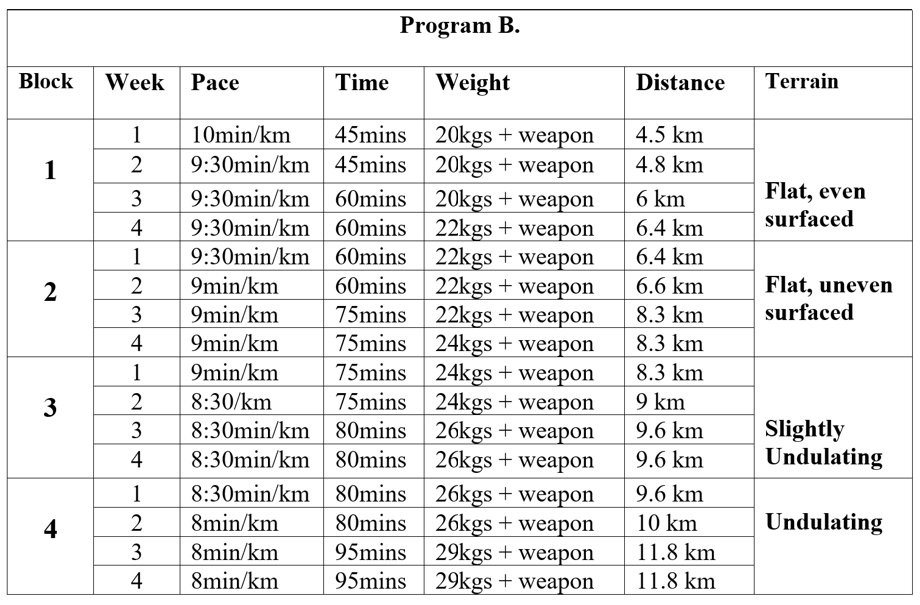To conduct a Weight Loaded March (WLM) program you first need to identify your goal (e.g. selection). Once you understand your goal you should develop a program using the “underlying principles” that form the basis of the Conditioning and Consideration Principles. These principles can be found in the 'ASI(P), Part 8 Chapter 4 – Physical Training' or the 'LWP-G 7-7-4 Fitness Handbook' (only available on DPN).
Underlying principles
- Specificity
- Overload
- Fatigue management
- Recovery
- Reversibility
- Individuality
Specificity – The main energy system focus of WLM is aerobic capacity, the best way to achieve this is by conducting a WLM program designed around the specific goal you want to achieve. If you are training for a timed WLM (i.e. selection) you would ideally target the weight, time and distance of the assessment. However, if you are trying to improve your fitness for field, the focus would be on weight and time under load. In this instance your pace would be significantly slower, to closer replicate patrol rates (Program A).
Overload – When an individual is subject to a training stimulus creating fatigue, the next time they are exposed to the same stimulus they should adapt to it and produce less strain on the body. The aim is to gradually increase the stimulus, through progressive overload by increasing one variable at a time. These variables can be; time under tension, increased weight, or speed in which a person is moving. Stimulus can also be created training on terrain similar to the field environment i.e. undulating, uneven terrain.
Fatigue Management – Once your threshold has been exceeded there is a temporary time that your capacity to perform will be reduced. To ensure appropriate fatigue management It is important that when conducting your program, WLM’s do not fall on days after intense training. This will allow adequate time for the body to adapt to the demands placed on it and decrease the likelihood of injury.
Recovery – When you pair your training with appropriate recovery, your body will adapt, enabling super compensation and improved performance capacity (Graph 1). generally, it takes 24/48hrs for the body to recover from intense training. However, activities such as load carriage, marching and obstacle training in boots and field dress may take longer. When training through heavy periods of volume and intensity, it can take up to 10 days for total adaptation to occur at a cellular level. If you get recovery wrong, it could take weeks or months to fully recover.

Graph 1
Reversibility – Reversibility occurs when you don’t conduct enough training to facilitate adaptations, or program inadequate recovery between hard training sessions. After one to three weeks of physical inactivity there are significant reductions in capacity. Depending on how long you have been training, many training improvements are lost within several months and can take a significant amount of time to regain them.
Individuality – When developing a program, it is ideal to consider your individual fitness. Tailoring the program to your fitness is vital in ensuring you achieve your goals and avoid injury.
Other Considerations – If you are injured or particularly sore and fatigued, you can adjust your WLM’s accordingly. If you feel your body is struggling to adapt to the load, you may need to repeat the previous weeks WLM without increasing one of the variable’s. Another way you can improve your ability to WLM without the external load is to conduct a low impact aerobic capacity session on a stationary bike, rower or swimming laps in a pool for the same duration as your intended WLM.
For optimal training results, it is recommended that a WLM program be conducted in conjunction with an aerobic, strength and recovery program.
Example Programs
Below are examples of two specific programs. Program A targets time under load at a slow pace to replicate patrol rates and Program B for weight, time and distance:
Program A is a field specific WLM program utilising time under load at a slow pace over undulating terrain. This program demonstrates a WLM every fortnight as opposed to the traditional weekly WLM.

Program B is a program specific to moving fast across flatter open terrain at a goal pace of 8min/km. The program is set up in blocks, these sessions can be conducted weekly or fortnightly and spread over 3-6 months, or until you reach your desired goal. This program is more advanced and is recommended for those that have a longer training life and experience.

Notes
- Block – Each block will consist of four weeks and can be spread over 1-2 months, depending if you want to pack march weekly or fortnightly.
- Pace – You should start at 2 min’s slower than your goal pace per 1km and increase your pace by 15 seconds in the second week of each four-week block, until you reach your goal pace.
- Time – you should increase your time by 15 minutes every third week into your block.
- Weight – In the fourth week of every block increase the weight by 10% until you reach goal weight.
- Distance – your distance will increase in accordance with your goal pace and time increase’s. (eg Your pace is 9 min/k and you’re travelling for 45 minutes 45min/8km/hr = 5.6kms)
- Terrain – Change the terrain each block to add a different stimulus to your training.
Summary
No training program should be absolute and must be developed with appropriate consideration to the underlying principles. Having an honest understanding of your current fitness, abilities and goals will enable the planning and application of the principles to optimise your training. If you are inexperienced or unsure, reach out to your Fitness Leaders or PTIs.










Similarly the optimisation of body composition to reduce body fat (excess weight) is so very important. Unfortunately most people still believe the fallacy that this weight loss happens primarily by exercising or caloric expenditure which is largely a myth. Weight loss is primarily caused by reducing consumption of sugar and simple carbohydrates.
Thanks for the article
Cheers